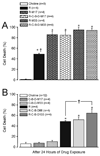Neurotoxicity of adjuvants used in perineural anesthesia and analgesia in comparison with ropivacaine
- PMID: 21519308
- PMCID: PMC3085859
- DOI: 10.1097/AAP.0b013e3182176f70
Neurotoxicity of adjuvants used in perineural anesthesia and analgesia in comparison with ropivacaine
Abstract
Background and objectives: Clonidine, buprenorphine, dexamethasone, and midazolam (C, B, D, M) have been used to prolong perineural local anesthesia in the absence of data on the influence of these adjuvants on local anesthetic-induced neurotoxicity. Therefore, the impact of these adjuvants on ropivacaine (R)-induced death of isolated sensory neurons was assessed.
Methods: The trypan blue exclusion assay was used to assess death of sensory neurons isolated from adult male Sprague-Dawley rats. Drugs were applied, alone or in combination, for 2 or 24 hrs at 37°C.
Results: Neuronal viability was halved by 24-hr exposure to R (2.5 mg/mL), far exceeding the neurotoxicity of C, B, D, or M (at 2-100 times estimated clinical concentrations). Plain M at twice the estimated clinical concentration produced a small but significant increase in neurotoxicity at 24 hrs. After 2-hr exposure, high concentrations of B, C, and M increased the neurotoxicity of R; the combination of R + M killed more than 90% of neurons. Estimated clinical concentrations of C + B (plus 66 μg/mL D) had no influence on (i) R-induced neurotoxicity, (ii) the increased neurotoxicity associated with the combination of R + M, or (iii) the neurotoxicity associated with estimated clinical concentrations of M. There was increased neurotoxicity with 133 μg/mL D combined with R + C + B.
Conclusions: Results with R reaffirm the need to identify ways to mitigate local anesthetic-induced neurotoxicity. While having no protective effect on R-induced neurotoxicity in vitro, future research with adjuvants should address if the C + B + D combination can enable reducing R concentrations needed to achieve equianalgesia (and/or provide equal or superior duration, in preclinical in vivo models).
Figures



Comment in
-
All adjuvants to local anesthetics were not created equal: animal data evaluating neurotoxicity, thermal hyperalgesia, and relevance to human application.Reg Anesth Pain Med. 2011 May-Jun;36(3):211-2. doi: 10.1097/AAP.0b013e3182176ed0. Reg Anesth Pain Med. 2011. PMID: 21508791 No abstract available.
References
-
- Eisenach JC, De Kock M, Klimscha W. Alpha(2)-adrenergic agonists for regional anesthesia. A clinical review of clonidine (1984–1995) Anesthesiology. 1996;85:655–674. - PubMed
-
- McCartney CJL, Duggan E, Apatu E. Should we add clonidine to local anesthetic for peripheral nerve blockade? A qualitative systematic review of the literature. Reg Anesth Pain Med. 2007;32:330–338. - PubMed
-
- Popping DM, Elia N, Marret E, Wenk M, Tramer MR. Clonidine as an adjuvant to local anesthetics for peripheral nerve and plexus blocks: A meta-analysis of randomized trials. Anesthesiology. 2009;111:406–415. - PubMed
-
- Candido KD, Franco CD, Khan MA, Winnie AP, Raja DS. Buprenorphine added to the local anesthetic for brachial plexus block to provide postoperative analgesia in outpatients. Reg Anesth Pain Med. 2001;26:352–356. - PubMed
-
- Candido KD, Winnie AP, Ghaleb AH, Fattouh MW, Franco CD. Buprenorphine added to the local anesthetic for axillary brachial plexus block prolongs postoperative analgesia. Reg Anesth Pain Med. 2002;27:162–167. - PubMed
Publication types
MeSH terms
Substances
Grants and funding
LinkOut - more resources
Full Text Sources
Medical
